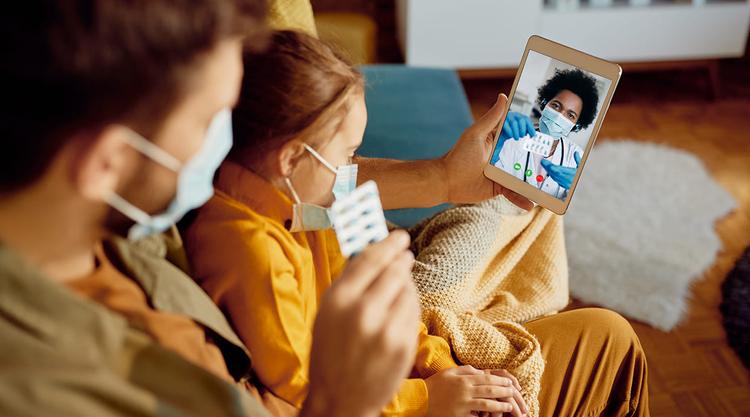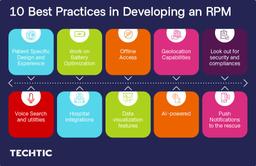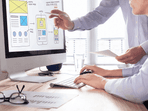Remote Patient Monitoring App Development Best Practices
Sector: Digital Product
Author: Sweta Patel
Date Published: 11/05/2020

Contents
Did you know that back in 2019 – way before the onset of a global pandemic – over 52% of consumers revealed that they would use a connected health device if they were recommended by a physician?
Yes!
They say modern problems require modern solutions and nothing can do complete justice to this notion than a remote patient monitoring app that has been making waves in the telehealth sector over the years.
For those of you who didn’t know what it is, here’s a quick intro.
What is a Remote Patient Monitoring App?
An RPM or a Remote Patient Monitoring App is a computer or software application that allows doctors and physicians to virtually monitor the health statuses and conditions of their patients from wherever they are.
From vitals to specific health-related information, these applications can track and share them all with stakeholders, allowing clinics and hospitals to offer personalized treatments and patient care and reduce several operational expenses.
If you’re a healthcare software development company that is looking to develop and roll out an RPM, there are specific factors you should consider. And to make your task easier, here are some of the best practices in developing a remote patient monitoring app.
10 Best Practices in Developing Remote Patient Monitoring App

1. Patient Specific Design and Experience
If you think, RPM healthcare application development is all about making it usable for patients. They are your primary users, followed by doctors and physicians. But predominantly, it is the elderly people or patients. And that’s why you need to make the design and user experience as patient-friendly as possible. Some of the features you could incorporate include:
- A cleaner more minimal interfaces with bigger buttons
- Very specific CTAs that are comprehensible for all
- Lock screen widgets
- Less interactive elements
- Bigger icons and more
2. Work on Battery Optimization
An RPM app is something that needs to be perpetually on to consistently keep track of physical conditions. And like you know, this consumes a lot of battery and when the battery drains, the recording and transmission of data abruptly ends as well. To prevent this, your app must be designed to go easy on the device’s battery consumption. For this, you could limit several background processes while the app runs, introduce a battery saver mode for your app, notify users when data transmission is cut and more.
3. Offline Access
Apart from battery issues, a device could also face internet connectivity outage. During such instances, your app should be designed to consistently collect data without facing any abrupt disruption. We are dealing with vital patient information and that’s why you need to incorporate caching mechanisms. You could also introduce local notifications so there’s very less dependency on servers.
4. Geolocation Capabilities
Geolocation features are inevitable in the development of an RPM. By introducing geolocation features, you can let your users know of the nearest hospital or clinic in case of emergencies to foster immediate attention and patient care. Notifications to stakeholders and automatic appointments with nearest hospitals can be worked on using such capabilities.
5. Look out for security and compliances
Though these factors should be considered without someone giving you a suggestion, it’s still a responsibility on our side to remind you of the legalities and compliances in running RPM apps. When you are developing, ensure your app follows compliances of HL7, HIPAA, HFIR and gets an FDA clearance. And if your app is to be connected to a wearable device such as a sensor or a tracker, you should also be looking at the IEC 62304 standards.
6. Voice Search and utilities
Remember we told you about patient-specific UI? To add another layer to that, include voice search and dictation functionalities. This will allow patients and elderly take minimal efforts in operating your app.
7. Hospital integrations
A remote patient monitoring app is effective as long as it supports data interoperability among stakeholders like clinics, physicians, patients and more. Only when a doctor can look at the data and process it can diagnosis and treatment can be initiated. So your mobile app development team should look at connecting your app with electronic health records and portals without breaching confidential data.A remote patient monitoring app is effective as long as it supports data interoperability among stakeholders like clinics, physicians, patients and more. Only when a doctor can look at the data and process it can diagnosis and treatment can be initiated. So your mobile app development team should look at connecting your app with electronic health records and portals without breaching confidential data.
8. Data visualization features
Your app collects data for several reasons and one of them is to actively involve patients in their recovery and treatments. But that can’t be done if what they are looking at makes no sense. That’s why data visualization is key and your app should present the data it collects in the most seamless ways possible. The clearer the information, the more the app usage.
9. AI-powered
Supercharge your RPM with as many artificial intelligence capabilities as possible. Work on implementing preventive care and automation so patient health is never compromised at any instance of time. From predicting illnesses to autonomously making appointments, integrate life-saving features.
10. Push Notifications to the rescue
Push notifications are designed to engage better with your users. And for patients and doctors alike, engagement is necessary. Use the app’s push notification features to send out vital information about health conditions, doctor’s availability, rescheduling of appointments, regular check ups and more.
Wrapping Up
So, these were the essential best practices you need to implement when developing a remote patient monitoring app. If this sounds too much to assimilate, leave this job to the expert healthcare app developers by simply getting in touch with a solid healthcare app development company like us.
We are a premier custom healthcare app development company who have been offering healthcare app development services for decades. Our expertise is what you need to make your RPM app stand out in the market.
Reach out to us today.
Latest Tech Insights!
Join our newsletter for the latest updates, tips, and trends.







